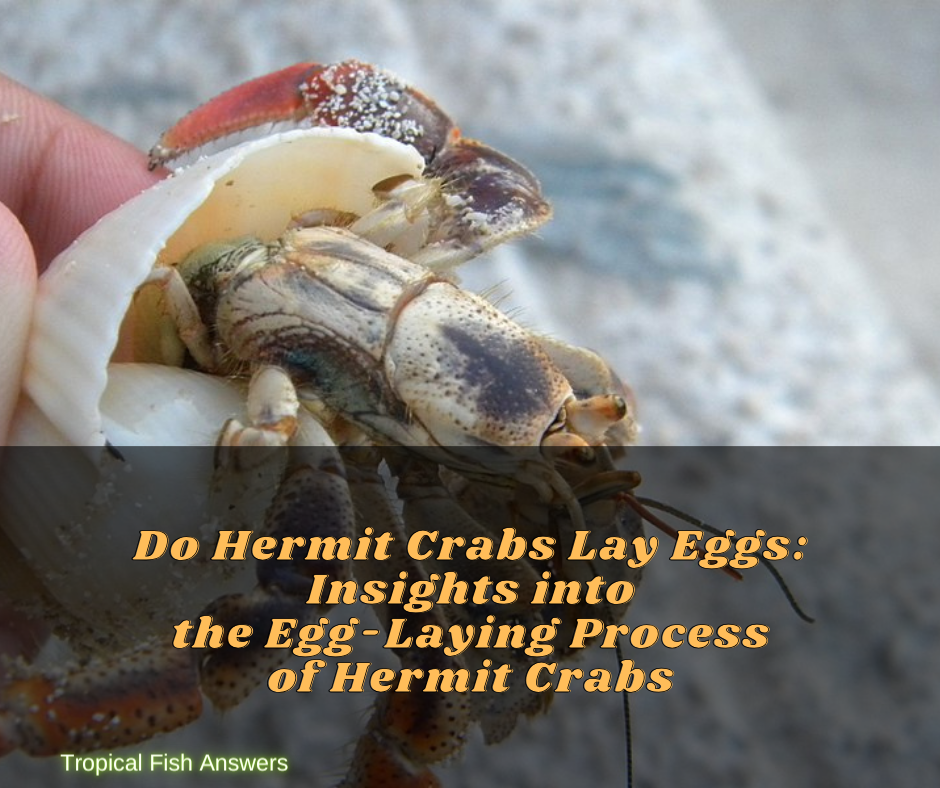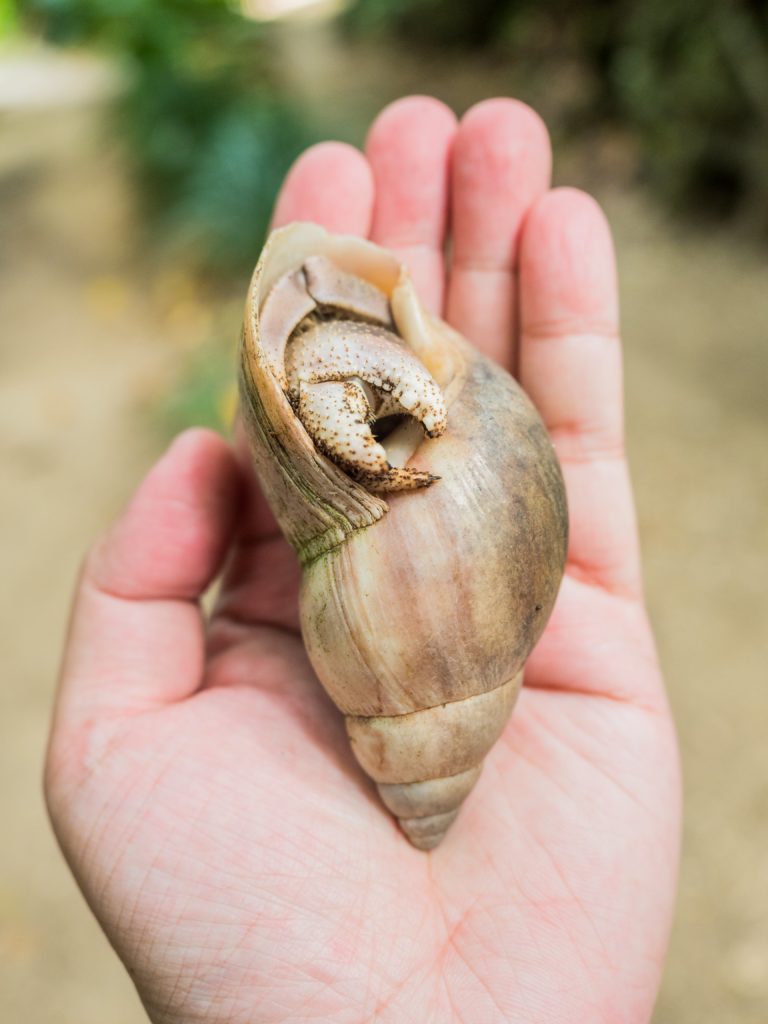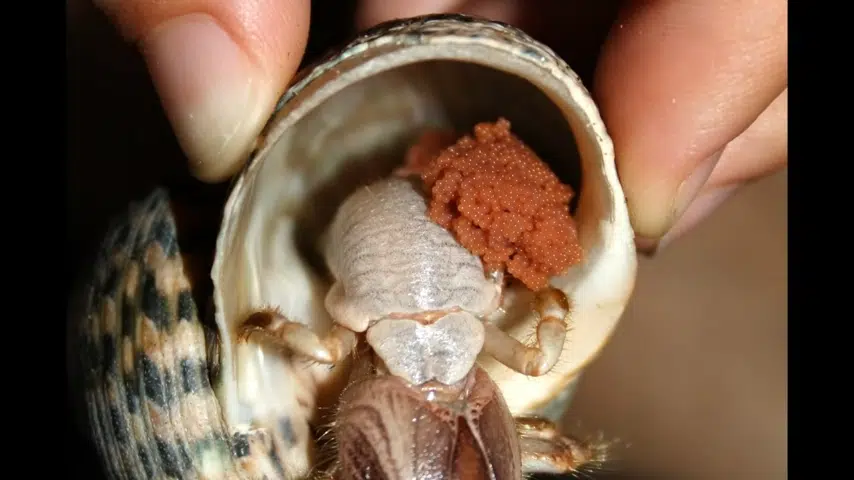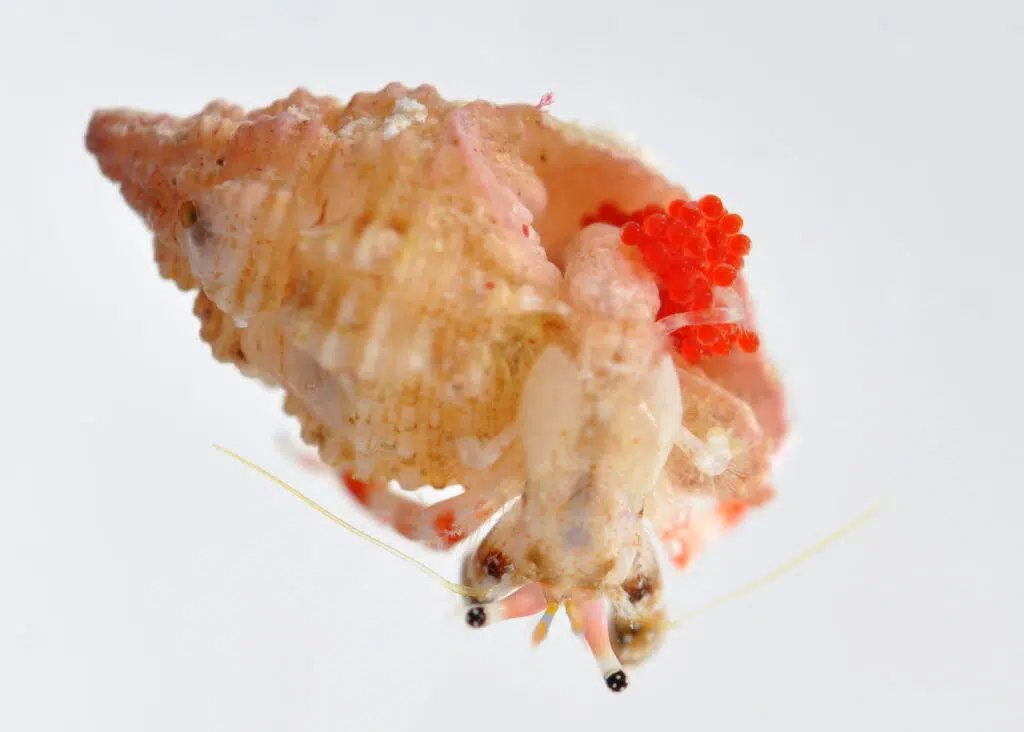Do Hermit Crabs Lay Eggs? Introduction
Overview of hermit crabs and their reproductive process
Hermit crabs, specifically the species Coenobito Clypeatus, go through various stages in their life cycle. One fascinating aspect of their reproductive process is the ability of the female hermit crab to hold several hundred eggs inside her shell while they mature. As the eggs develop, they gradually hang out over the edge of the shell. This unique reproductive behavior is a crucial part of the hermit crab’s life cycle.
Importance of understanding the egg-laying process in hermit crabs
Understanding the egg-laying process in hermit crabs is essential for several reasons.
- Conservation: Hermit crabs are an important part of marine ecosystems. Knowledge about their reproduction helps in conservation efforts, as it enables scientists to assess population decline and improve management strategies to protect these fascinating creatures.
- Ecological studies: By studying the reproductive processes of hermit crabs, researchers can gain insights into the ecology and behavior of these animals. It provides valuable information about their habitat preferences, mating behaviors, and the impact of environmental factors on their population dynamics.
- Education and Awareness: By sharing information about the egg-laying process of hermit crabs, we can raise awareness about these amazing marine creatures. Educating the public about the importance of coastal ecosystems and the role hermit crabs play in maintaining biodiversity encourages conservation efforts and responsible beach activities.
- Captive care: Understanding how hermit crabs reproduce is crucial for those who keep them as pets. It ensures that proper care is provided, including appropriate environments for them to lay and hatch their eggs.
In conclusion, the egg-laying process of hermit crabs, such as Coenobito Clypeatus, is a fascinating aspect of their life cycle. Understanding this process is not only important for scientific research and conservation efforts but also for those who keep hermit crabs as pets. By gaining knowledge about their reproductive behavior, we can contribute to the preservation of these marvelous creatures and their ecosystems.
Understanding Hermit Crab Reproduction
Overview of hermit crab mating behavior
Hermit crabs, specifically the species Coenobito Clypeatus, have a fascinating reproductive process. During a mating ritual, which often occurs in mass gatherings near the water, both males and females partially emerge from their shells. The male then transfers a spermatophore to the female, which implants and can result in thousands of eggs being deposited along the female’s abdomen. This unique behavior allows for successful fertilization and the continuation of the hermit crab life cycle.
Factors affecting the decision to lay eggs or give birth to live young
Hermit crabs have the ability to either lay eggs or give birth to live young, depending on various factors. These factors can include:
- Environmental conditions: The temperature and humidity of the surroundings can play a role in determining whether a hermit crab chooses to lay eggs or give birth to live young.
- Available resources: The availability of food and suitable habitats can influence the reproductive strategy of hermit crabs. If resources are abundant, they may be more likely to lay eggs, while scarce resources may encourage giving birth to live young.
- Genetic factors: The genetic makeup of individual hermit crabs can also impact their reproductive strategy. Some individuals may have a higher propensity for laying eggs, while others may have adaptations for giving birth to live young.
Understanding these factors is important for researchers studying hermit crab reproduction. It allows for a better understanding of the ecological dynamics and population trends of these fascinating creatures. Additionally, this knowledge is crucial for those who keep hermit crabs as pets, as it helps ensure proper care and appropriate environments for successful reproduction.
In conclusion, the reproductive behavior of hermit crabs, such as Coenobito Clypeatus, is an intriguing aspect of their life cycle. By understanding the mating behavior and factors influencing reproductive strategies, we can gain valuable insights into the ecology and behavior of these creatures. This knowledge is not only important for scientific research but also for the conservation and responsible pet ownership of hermit crabs.
The Egg-Laying Process
Female hermit crab’s preparation for egg-laying
Before a female hermit crab lays her eggs, she goes through a preparation process. She holds several hundred eggs inside her shell, where they mature until they are ready to hatch. The eggs are attached to her abdomen and appendages, believed to have been fertilized by a male during the mating process. As they grow, the eggs hang out over the shell.
Detailed description of the egg-laying process
When the female hermit crab is ready to lay her eggs, she typically goes to the ocean to release them. To do this, she scrapes her appendages, allowing the eggs to be released into the water. This process ensures that the offspring have the best chance of survival and allows for their dispersal in the ocean. The released eggs will continue to develop and hatch outside the protection of the female’s shell.
Overall, understanding the reproduction process of hermit crabs, particularly the egg-laying process in female hermit crabs, provides valuable insights into their life cycle and ecological dynamics. Factors such as environmental conditions, available resources, and genetic factors can influence the decision of whether a hermit crab lays eggs or gives birth to live young. Researchers studying hermit crab reproduction can utilize this knowledge to gain a better understanding of population trends and ecological patterns in these fascinating creatures.
Furthermore, this understanding is crucial for those who keep hermit crabs as pets. Providing suitable environments and ensuring proper care is essential for the successful reproduction and well-being of pet hermit crabs.
In conclusion, the egg-laying process in female hermit crabs is a complex and intriguing aspect of their reproductive behavior. By delving deeper into this process and the factors influencing it, we can enhance our knowledge of these unique creatures and contribute to their conservation and responsible pet ownership practices.
Incubation and Hatching of Eggs
Incubation period and conditions required for successful egg development
After the female hermit crab releases her eggs into the ocean, the incubation period begins. The duration of this period can vary depending on factors such as temperature, water quality, and food availability. On average, it takes around 30 to 40 days for the eggs to hatch.
During the incubation period, it is important to provide the right conditions to ensure the successful development of the eggs. The water temperature should be maintained between 75 to 80 degrees Fahrenheit (24 to 27 degrees Celsius), replicating the natural conditions of the ocean. The water quality should be closely monitored, with regular water changes and the use of a filtration system to prevent any harmful buildup of ammonia or other toxins. Additionally, providing a varied and nutritious diet for the female hermit crab during this period can contribute to the health and development of the eggs.
Hatching process and survival rate of hermit crab eggs
As the incubation period comes to an end, the eggs will start to hatch. The hatching process typically occurs at night. The baby hermit crabs, known as larvae, emerge from the eggs and make their way into the water.
The survival rate of hermit crab eggs can vary depending on various factors such as water conditions, predation, and the availability of food sources for the larvae. It is estimated that only a small percentage of the hatched larvae will survive to reach adulthood.
To improve the chances of survival for the hatched larvae, it is important to provide them with a suitable environment. This includes maintaining proper water temperature and quality, providing hiding places or structures for the larvae to seek refuge from predators, and offering a nutritious diet specifically formulated for their needs.
Continued monitoring and observation are crucial during the hatching process to ensure that the conditions are optimal for the survival of the larvae. By documenting and sharing this information, researchers and hermit crab enthusiasts can contribute to our collective knowledge and understanding of the intricacies of hermit crab reproduction.
In conclusion, the incubation and hatching of hermit crab eggs is a critical phase in their life cycle. By providing the right conditions and closely monitoring the process, we can increase the chances of successful hatching and contribute to the conservation and responsible pet ownership practices for these fascinating creatures.
Live Birth in Hermit Crabs
Explanation of live birth in hermit crabs
The birth of hermit crabs is a fascinating process that involves either eggs hatching or live birth. While most hermit crab species reproduce by laying eggs, there are certain species that have evolved to give live birth. Live birth in hermit crabs is known as “ovoviviparity,” where the eggs develop inside the female’s body until they are ready to hatch.
Unlike egg-laying species, female hermit crabs hold the developing eggs internally. The eggs receive nourishment and protection inside the female’s shell until they are mature enough to hatch. When the time comes, the female releases the fully-formed baby hermit crabs into the water, where they begin their journey to adulthood.
Factors influencing the occurrence of live birth in hermit crabs
The occurrence of live birth in hermit crabs is influenced by various factors. One of the key factors is the species itself. Some hermit crab species have evolved to give live birth as a means of increasing the survival rate of their offspring in certain environments.
Environmental factors also play a role in determining whether a hermit crab species exhibits live birth. Factors such as temperature, water quality, and food availability can influence the reproductive strategy of hermit crabs. In habitats where resources are limited or conditions are challenging, live birth may be advantageous as it allows the female to provide direct care and protection to the developing offspring.
It is important to study and understand the factors that influence live birth in hermit crabs to conserve and protect these unique creatures. By conducting research and sharing knowledge, we can contribute to the preservation of hermit crab populations and promote responsible pet ownership practices.
Understanding the intricacies of hermit crab reproduction, whether through egg hatching or live birth, sheds light on the complexity of their life cycle and enables us to better appreciate and care for these amazing creatures.
Environmental Factors and Egg-Laying Behavior
Impact of environmental conditions on hermit crab reproductive behavior
The reproductive behavior of hermit crabs, including the decision to lay eggs, is heavily influenced by various environmental conditions. These conditions can affect the availability of resources, the survival rate of offspring, and overall reproductive success.
Temperature is one critical environmental factor that can significantly impact hermit crab reproductive behavior. Warmer temperatures can accelerate egg development and increase the chances of successful hatching. Conversely, cooler temperatures may slow down egg development and reduce the likelihood of viable offspring.
Water quality is another essential environmental factor that can affect egg-laying behavior. Hermit crabs rely on clean and unpolluted water for successful reproduction. Poor water quality, contaminated with pollutants or toxins, can lead to reduced fertility and disrupted egg-laying behavior.
Availability of food and its influence on egg-laying behavior
The availability of food resources also plays a crucial role in hermit crab egg-laying behavior. Adequate nutrition is vital for the female hermit crab to produce healthy eggs and maintain reproductive fitness.
In environments with abundant food resources, female hermit crabs are more likely to engage in egg-laying behavior. Sufficient nutrition provides the energy and resources necessary for reproductive activities. On the other hand, when food is scarce, females may delay or forgo egg-laying to preserve their own health and survival.
Competition for food resources can also impact egg-laying behavior. If multiple hermit crabs are vying for limited food, it may result in decreased reproductive activities as individuals prioritize their own survival over reproduction.
Understanding the influence of environmental factors on hermit crab reproductive behavior is crucial for their conservation and management. By identifying and mitigating threats such as habitat degradation, pollution, and food scarcity, we can help ensure the continued reproductive success of these fascinating creatures.
Environmental Factors and Egg-Laying Behavior
Impact of environmental conditions on hermit crab reproductive behavior
The reproductive behavior of hermit crabs, including the decision to lay eggs, is heavily influenced by various environmental conditions. These conditions can affect the availability of resources, the survival rate of offspring, and overall reproductive success.
Temperature is one critical environmental factor that can significantly impact hermit crab reproductive behavior. Warmer temperatures can accelerate egg development and increase the chances of successful hatching. Conversely, cooler temperatures may slow down egg development and reduce the likelihood of viable offspring.
Water quality is another essential environmental factor that can affect egg-laying behavior. Hermit crabs rely on clean and unpolluted water for successful reproduction. Poor water quality, contaminated with pollutants or toxins, can lead to reduced fertility and disrupted egg-laying behavior.
Availability of food and its influence on egg-laying behavior
The availability of food resources also plays a crucial role in hermit crab egg-laying behavior. Adequate nutrition is vital for the female hermit crab to produce healthy eggs and maintain reproductive fitness.
In environments with abundant food resources, female hermit crabs are more likely to engage in egg-laying behavior. Sufficient nutrition provides the energy and resources necessary for reproductive activities. On the other hand, when food is scarce, females may delay or forgo egg-laying to preserve their own health and survival.
Competition for food resources can also impact egg-laying behavior. If multiple hermit crabs are vying for limited food, it may result in decreased reproductive activities as individuals prioritize their own survival over reproduction.
Adaptations for Survival
Evolutionary adaptations for hermit crab reproduction
Hermit crabs have evolved several adaptations that enhance their reproductive success in their diverse habitats. These adaptations include:
- Ability to lay multiple clutches of eggs
- Strong osmoregulation abilities
- Capability to mate partially emerged from their shells
These adaptations allow hermit crabs to maximize the chances of successful reproduction, even in challenging environments.
Benefits and challenges of different reproductive strategies
Hermit crabs exhibit a variety of reproductive strategies, each with its own benefits and challenges. Some key strategies include:
| Reproductive Strategy | Benefits | Challenges |
|---|---|---|
| Obligate strong osmoregulation | Adapted to terrestrial environments | Dependence on specific environmental conditions |
| Marine crabs | Ability to utilize marine resources | Competition with other marine species |
Understanding these different reproductive strategies can provide valuable insights into the ecological dynamics of hermit crabs and their ability to survive and reproduce in diverse habitats.
Comparison with Other Crustaceans
Contrasting the reproductive strategies of hermit crabs with other crustaceans
The reproductive strategies of hermit crabs differ significantly from those of other crustaceans in several key ways. While hermit crabs have adapted to utilize a range of habitats, including terrestrial and marine environments, many other crustaceans have more specific requirements for reproduction.
For example, some crustaceans, like lobsters and crayfish, have a more direct method of reproduction, where the female carries eggs attached to her pleopods until they hatch. In contrast, hermit crabs lay clusters of eggs in the ocean, with the female passing them from her pleopods using her grooming appendages. This distinction in egg-laying behavior reflects the unique challenges and adaptations of each crustacean species.
Insights into the evolutionary significance of hermit crab reproduction
The reproductive adaptations and strategies of hermit crabs offer valuable insights into their evolutionary history and ecological niche. By being able to lay multiple clutches of eggs and mate partially emerged from their shells, hermit crabs have developed specific mechanisms to maximize their reproductive success.
These adaptations highlight the importance of environmental factors, such as temperature and water quality, in shaping reproductive behavior. They also illustrate the trade-offs that hermit crabs may face, such as competition for food resources and the need to balance their own survival with reproductive efforts.
Studying the reproductive strategies of hermit crabs allows us to better understand their place in the broader ecosystem and the challenges they face in maintaining their populations. By uncovering these evolutionary adaptations, researchers can gain a deeper appreciation for the remarkable diversity of crustacean reproduction and its role in their survival and success.
Conclusion
Recap of Key Insights into the Egg-Laying Process of Hermit Crabs
In contrast to other crustaceans, hermit crabs lay clusters of eggs in the ocean and use their grooming appendages to pass the eggs from their pleopods. This unique strategy reflects the adaptability and resourcefulness of hermit crabs, allowing them to thrive in various environments.
Importance of Further Research in Understanding Hermit Crab Reproduction
As we continue to uncover the intricacies of hermit crab reproduction, further research is crucial for gaining a comprehensive understanding of their reproductive biology. This knowledge can help inform conservation efforts and ensure the long-term survival of hermit crab populations.
FAQ: Do Hermit Crabs Lay Eggs? Insights into the Egg-Laying Process of Hermit Crabs
Q: Do hermit crabs lay eggs?
A: Yes, hermit crabs are capable of laying eggs.
Q: How do hermit crabs reproduce?
A: Hermit crabs reproduce through a process called sexual reproduction, which involves a male and female crab.
Q: Can all species of hermit crabs lay eggs?
A: No, not all species of hermit crabs are capable of laying eggs. Only certain species have the ability to reproduce and lay eggs.
Q: What triggers the egg-laying process in hermit crabs?
A: The egg-laying process in hermit crabs is triggered by a combination of environmental factors, such as temperature, humidity, and the availability of food.
Q: How often do hermit crabs lay eggs?
A: The frequency of egg-laying can vary among different species of hermit crabs. Some species may lay eggs multiple times a year, while others may lay eggs less frequently.
Q: Where do hermit crabs lay their eggs?
A: Female hermit crabs typically lay their eggs in underground burrows, providing a safe and protected environment for the developing eggs.
Q: How many eggs do hermit crabs lay at a time?
A: The number of eggs laid by a female hermit crab can vary depending on the species. Some may lay just a few eggs, while others may lay hundreds at a time.
Q: What do hermit crab eggs look like?
A: Hermit crab eggs are usually small and spherical, ranging in color from white to cream-colored. They may have a slightly transparent appearance.
Q: How long does it take for hermit crab eggs to hatch?
A: The incubation period for hermit crab eggs varies depending on the species and environmental conditions. It can range from several weeks to several months.
Q: What happens after the hermit crab eggs hatch?
A: Once the eggs hatch, tiny larvae, known as zoea, emerge. These larvae are released into the water and undergo a series of molts and development stages before becoming juvenile hermit crabs.
Q: How do hermit crabs care for their eggs?
A: Hermit crabs do not provide parental care for their eggs. Once the eggs are laid, the female crab leaves them in their burrow and does not play a role in their development.
Q: Can hermit crabs reproduce in captivity?
A: Yes, hermit crabs can reproduce in captivity if the appropriate environmental conditions are provided and if a male and female crab are present.
Q: Is it advisable to remove hermit crab eggs from their natural habitat?
A: It is generally discouraged to disturb hermit crab eggs in their natural habitat. They play an important role in the natural ecosystem, and removing eggs can disrupt the balance.
Q: How can I provide suitable conditions for hermit crabs to lay eggs in captivity?
A: To provide suitable conditions for hermit crabs to lay eggs in captivity, it is important to maintain appropriate temperature, humidity, and a varied diet. Creating a secure and spacious environment with suitable hiding places can also encourage egg-laying behavior.
Q: Can hermit crabs lay eggs without mating?
A: No, hermit crabs require mating between a male and female crab in order for the female to produce fertile eggs. Parthenogenesis, or the ability to reproduce without mating, is not observed in hermit crabs.
Q: Are hermit crab eggs easy to hatch and raise in captivity?
A: Raising hermit crab eggs in captivity can be a challenging task. It requires specific equipment, knowledge of the species, and attention to environmental conditions. Due to the complex nature of the hatching process, it is not recommended for inexperienced hermit crab owners.
In conclusion, hermit crabs do lay eggs, but not all species have the ability to reproduce. The egg-laying process is influenced by various environmental factors, and female hermit crabs typically lay their eggs in underground burrows. The number, appearance, and hatching time of the eggs vary among species. While hermit crabs can reproduce in captivity, successfully hatching and raising the eggs requires expertise and appropriate environmental conditions.





